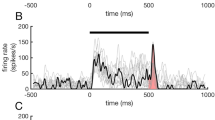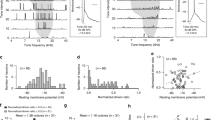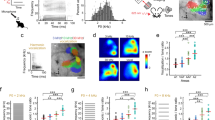Abstract
Neurons in the rat primary auditory cortex (A1) generally cannot respond to tone sequences faster than 12 pulses per second (pps). To test whether experience can modify this maximum following rate in adult rats, trains of brief tones with random carrier frequency but fixed repetition rate were paired with electrical stimulation of the nucleus basalis (NB) 300 to 400 times per day for 20–25 days. Pairing NB stimulation with 5-pps stimuli markedly decreased the cortical response to rapidly presented stimuli, whereas pairing with 15-pps stimuli significantly increased the maximum cortical following rate. In contrast, pairing with fixed carrier frequency 15-pps trains did not significantly increase the mean maximum following rate. Thus this protocol elicits extensive cortical remodeling of temporal response properties and demonstrates that simple differences in spectral and temporal features of the sensory input can drive very different cortical reorganizations.
This is a preview of subscription content, access via your institution
Access options
Subscribe to this journal
Receive 12 print issues and online access
$209.00 per year
only $17.42 per issue
Buy this article
- Purchase on Springer Link
- Instant access to full article PDF
Prices may be subject to local taxes which are calculated during checkout


Similar content being viewed by others
References
Bakin, J. S. & Weinberger, N. M. Classical conditioning induces CS-specific receptive field plasticity in the auditory cortex of the guinea pig. Brain Res. 536, 271– 286 (1990).
Bakin, J. S., South, D. A. & Weinberger, N. M. Induction of receptive field plasticity in the auditory cortex of the guinea pig during instrumental avoidance conditioning. Behav. Neurosci. 110, 905–913 (1996).
Recanzone, G. H., Merzenich, M. M. & Jenkins, W. M. Frequency discrimination training engaging a restricted skin surface results in an emergence of a cutaneous response zone in cortical area 3a. J. Neurophysiol. 67, 1057– 1070 (1992).
Recanzone, G. H., Merzenich, M. M., Jenkins, W. M., Grajski, K. A. & Dinse, H. R. Topographic reorganization of the hand representation in cortical area 3b owl monkeys trained in a frequency-discrimination task. J. Neurophysiol. 67, 1031– 1056 (1992).
Recanzone, G. H., Schreiner, C. E. & Merzenich, M. M. Plasticity in the frequency representation of primary auditory cortex following discrimination training in adult owl monkeys. J. Neurosci. 13, 87–103 (1993).
Weinberger, N. M. Learning-induced changes of auditory receptive fields. Curr. Opin. Neurobiol. 3, 570–577 ( 1993).
Xerri, C., Coq, J. O., Merzenich, M. M. & Jenkins, W. M. Experience-induced plasticity of cutaneous maps in the primary somatosensory cortex of adult monkeys and rats. J. Physiol. (Paris) 90, 277–287 (1996).
Kilgard, M. P. & Merzenich, M. M. Cortical map reorganization enabled by nucleus basalis activity [see comments]. Science 279, 1714–1718 (1998).
Bakin, J. S. & Weinberger, N. M. Induction of a physiological memory in the cerebral cortex by stimulation of the nucleus basalis [see comments]. Proc. Natl. Acad. Sci. USA 93, 11219– 11224 (1996).
Bjordahl, T. S., Dimyan, M. A. & Weinberger, N. M. Induction of long-term receptive field plasticity in the auditory cortex of the waking guinea pig by stimulation of the nucleus basalis. Behav. Neurosci. 112, 467– 479 (1998).
Mesulam, M. M., Mufson, E. J., Wainer, B. H. & Levey, A. I. Central cholinergic pathways in the rat: an overview based on an alternative nomenclature (Ch1-Ch6). Neuroscience 10, 1185–1201 (1983).
De Ribaupierre, F., Goldstein, M. H. Jr & Yeni-Komshian, G. Cortical coding of repetitive acoustic pulses. Brain Res. 48, 205– 225 (1972).
Tolhurst, D. J. & Movshon, J. A. Spatial and temporal contrast sensitivity of striate cortical neurones. Nature 257, 674–675 ( 1975).
Movshon, J. A., Thompson, I. D. & Tolhurst, D. J. Spatial and temporal contrast sensitivity of neurones in areas 17 and 18 of the cat's visual cortex. J. Physiol. (Lond.) 283, 101–120 ( 1978).
Schreiner, C. E. & Urbas, J. V. Representation of amplitude modulation in the auditory cortex of the cat. II. Comparison between cortical fields. Hear. Res. 32, 49–63 (1988).
Schreiner, C. E. & Langer, G. in Auditory Function (eds Edelman, G., Gall, E. & Cowan, M.) 337– 362 (John Wiley, New York, 1986).
Eggermont, J. J. & Smith, G. M. Synchrony between single-unit activity and local field potentials in relation to periodicity coding in primary auditory cortex. J. Neurophysiol. 73, 227–245 (1995).
Gaese, B. H. & Ostwald, J. Temporal coding of amplitude and frequency modulation in the rat auditory cortex. Eur. J. Neurosci. 7, 438–450 ( 1995).
Hawken, M. J., Shapley, R. M. & Grosof, D. H. Temporal-frequency selectivity in monkey visual cortex. Vis. Neurosci. 13, 477– 492 (1996).
De Ribaupierre, F., Goldstein, M. H. J. & Yeni-Komshian, G. Intracellular study of the cat's primary auditory cortex. Brain Res. 48, 185– 204 (1972).
Kenmochi, M. & Eggermont, J. J. Autonomous cortical rhythms affect temporal modulation transfer functions. Neuroreport 8, 1589–1593 (1997).
Chance, F. S., Nelson, S. B. & Abbott, L. F. Synaptic depression and the temporal response characteristics of V1 cells. J. Neurosci. 18, 4785– 4799 (1998).
Brosch, M. & Schreiner, C. E. Time course of forward masking tuning curves in cat primary auditory cortex. J. Neurophysiol. 77, 923–943 ( 1997).
Schreiner, C. E., Mendelson, J., Raggio, M. W., Brosch, M. & Krueger, K. Temporal processing in cat primary auditory cortex. Acta Otolaryngol. Suppl. (Stockh.) 532, 54–60 (1997).
Cartling, B. Control of computational dynamics of coupled integrate-and-fire neurons. Biol. Cybern. 76, 383–395 (1997).
Beaulieu, C. & Cynader, M. Effect of the richness of the environment on neurons in cat visual cortex. II. Spatial and temporal frequency characteristics. Dev. Brain Res. 53, 82– 88 (1990).
Pizzorusso, T., Fagiolini, M., Porciatti, V. & Maffei, L. Temporal aspects of contrast visual evoked potentials in the pigmented rat: effect of dark rearing. Vision Res. 37, 389–395 (1997).
Woodrow, H. The effect of practice upon time-order errors in the comparison of temporal intervals. Psychol. Rev. 42, 127– 152 (1935).
Neisser, U. & Hirst, W. Effect of practice on the identification of auditory sequences. Percept. Psychophys. 15, 391–398 (1974).
Recanzone, G. H., Jenkins, W. M., Hradek, G. T. & Merzenich, M. M. Progressive improvement in discriminative abilities in adult owl monkeys performing a tactile frequency discrimination task. J. Neurophysiol. 67, 1015–1030 (1992).
Nagarajan, S. S., Blake, D. T., Wright, B. A., Byl, N. & Merzenich, M. M. Practice-related improvements in somatosensory interval discrimination are temporally specific but generalize across skin location, hemisphere, and modality. J. Neurosci. 18, 1559–1570 (1998).
Wright, B. A., Buonomano, D. V., Mahncke, H. W. & Merzenich, M. M. Learning and generalization of auditory temporal-interval discrimination in humans. J. Neurosci. 17, 3956– 3963 (1997).
Ahissar, M. & Hochstein, S. Attentional control of early perceptual learning. Proc. Natl. Acad. Sci. USA 90, 5718–5722 (1993).
Merzenich, M. M. et al. Temporal processing deficits of language-learning impaired children ameliorated by training [see comments]. Science 271, 77–81 (1996).
Recanzone, G. H., Merzenich, M. M. & Schreiner, C. E. Changes in the distributed temporal response properties of SI cortical neurons reflect improvements in performance on a temporally based tactile discrimination task. J. Neurophysiol. 67, 1071–1091 (1992).
Charpier, S., Behrends, J. C., Triller, A., Faber, D. S. & Korn, H. "Latent" inhibitory connections become functional during activity-dependent plasticity. Proc. Natl. Acad. Sci. USA 92, 117–120 ( 1995).
Grabauskas, G. & Bradley, R. M. Tetanic stimulation induces short-term potentiation of inhibitory synaptic activity in the rostral nucleus of the solitary tract. J. Neurophysiol. 79, 595–604 (1998).
Hollrigel, G. S., Morris, R. J. & Soltesz, I. Enhanced bursts of IPSCs in dentate granule cells in mice with regionally inhibited long-term potentiation. Proc. R. Soc. Lond. B Biol. Sci. 265, 63–69 (1998).
Fischer, T. M., Blazis, D. E., Priver, N. A. & Carew, T. J. Metaplasticity at identified inhibitory synapses in Aplysia [see comments]. Nature 389, 860–865 (1997).
Buonomano, D. V., Hickmott, P. W. & Merzenich, M. M. Context-sensitive synaptic plasticity and temporal-to-spatial transformations in hippocampal slices. Proc. Natl. Acad. Sci. USA 94, 10403–10408 ( 1997).
Buonomano, D. V. & Merzenich, M. M. Temporal information transformed into a spatial code by a neural network with realistic properties. Science 267, 1028– 1030 (1995).
Markram, H. & Tsodyks, M. Redistribution of synaptic efficacy between neocortical pyramidal neurons [see comments]. Nature 382, 807–810 (1996).
Tsodyks, M. V. & Markram, H. The neural code between neocortical pyramidal neurons depends on neurotransmitter release probability [published erratum appears in Proc. Natl. Acad. Sci. USA 94, 5495, 1997]. Proc. Natl. Acad. Sci. USA 94, 719–723 (1997).
Metherate, R. & Weinberger, N. M. Acetylcholine produces stimulus-specific receptive field alterations in cat auditory cortex. Brain Res. 480, 372–377 ( 1989).
McKenna, T. M., Ashe, J. H. & Weinberger, N. M. Cholinergic modulation of frequency receptive fields in auditory cortex: I. Frequency-specific effects of muscarinic agonists. Synapse 4, 30–43 (1989).
Dinse, H. R. et al. Low-frequency oscillations of visual, auditory and somatosensory cortical neurons evoked by sensory stimulation. Int. J. Psychophysiol. 26, 205–227 ( 1997).
Abbott, L. F., Varela, J. A., Sen, K. & Nelson, S. B. Synaptic depression and cortical gain control [see comments]. Science 275 , 220–224 (1997).
Kelly, J. B. & Masterton, B. Auditory sensitivity of the albino rat. J. Comp. Physiol. Psychol. 91, 930– 936 (1977).
Jimenez-Capdeville, M. E., Dykes, R. W. & Myasnikov, A. A. Differential control of cortical activity by the basal forebrain in rats: a role for both cholinergic and inhibitory influences. J. Comp. Neurol. 381, 53– 67 (1997).
Rasmusson, D. D., Clow, K. & Szerb, J. C. Frequency-dependent increase in cortical acetylcholine release evoked by stimulation of the nucleus basalis magnocellularis in the rat. Brain Res. 594, 150– 154 (1992).
Acknowledgements
This work was supported by NIH grant NS-10414, ONR grant N00014-96-102, Hearing Research Inc. and an NSF predoctoral fellowship. We thank H.W. Mahncke, R.C. deCharms and C.E. Schreiner for technical advice, and S.S. Nagarajan, W.J. Martin, D.V. Buonomano, P. Bedenbaugh, A.I. Basbaum, K. Miller, C.E. Schreiner and E. Knudsen for comments on the manuscript.
Author information
Authors and Affiliations
Corresponding author
Rights and permissions
About this article
Cite this article
Kilgard, M., Merzenich, M. Plasticity of temporal information processing in the primary auditory cortex. Nat Neurosci 1, 727–731 (1998). https://doi.org/10.1038/3729
Received:
Accepted:
Issue Date:
DOI: https://doi.org/10.1038/3729
This article is cited by
Vagus nerve stimulation (VNS)-induced layer-specific modulation of evoked responses in the sensory cortex of rats
Scientific Reports (2020)
Transcriptional maturation of the mouse auditory forebrain
BMC Genomics (2015)



